Submitted:
29 May 2023
Posted:
30 May 2023
You are already at the latest version
Abstract
Keywords:
1. Introduction
2. Materials and Methods
2.1. Study Area
2.2. Data
2.3. Methods
3. Results
3.1. LST Seasonal Spatially analysis
3.1.1. LST Seasonal Spatially analysis
3.1.2. LST Statistical analysis
3.1.2.1. LST (OC) and area of LST (km2) seasonally
3.1.2.2. LST area changes compared to 2001-2005
3.2. LST Seasonal changes at the same location
3.2.1. Spatial analysis of LST Seasonal changes at the same location
3.2.2. Statistical analysis of LST Seasonal changes at the same location
3.3. LST analysis in Balikpapan, Samarinda, Bontang, and IKN zero point
3.3.1. LST Seasonal in Balikpapan, Samarinda, Bontang and IKN
3.3.2. Cross-sectional analysis of the LST
4. Discussions
5. Conclusions
Author Contributions
Funding
Data Availability Statement
Acknowledgments
Conflicts of Interest
References
- Urgensi Pemindahan Ibu Kota Negara. Available online: https://www.djkn.kemenkeu.go.id/kanwil-kalbar/baca-artikel/14671/Urgensi-Pemindahan-Ibu-Kota-Negara.html (accessed on 9 January 2023).
- Aslan, N. and Koc-San, D. Analysis of Relationship between Urban Heat Island Effect and Land Use/Cover Type using LANDSAT 7 ETM+ and LANDSAT 8 OLI Images. In Proceeding of The International Archives of the Photogrammetry, Remote Sensing and Spatial Information Sciences, XL-B8. Prague, Czech Republic, 12–19 July 2016., XL-B8. Prague. [CrossRef]
- Connors, J. P.; Galletti, C. S. and Chow, W. T. L. Landscape configuration and urban heat island effects: assessing the relationship between landscape characteristics and land surface temperature in Phoenix, Arizona. Landscape Ecology 2013, 28, 271–283. [Google Scholar] [CrossRef]
- McCarthy, M. P.; Best, M. J. and Betts, R. A. Climate change in cities due to global warming and urban effects, Geophysical Research Letters 2010, 37, L09705. [Google Scholar] [CrossRef]
- Azevedo, J.A.; Chapman, L. and Muller, C. L. Quantifying the Daytime and Night-Time Urban Heat Island in Birmingham, UK: A Comparison of Satellite Derived Land Surface Temperature and High Resolution Air Temperature Observations. Remote Sensing 2016, 8, 153. [Google Scholar] [CrossRef]
- Chapman, S.; Thatcher, M.; Salazar, A.; Watson, J. E. and McAlpine, C. A. The Effect of Urban Density andVegetation Cover on the Heat Island of a Subtropical City. Journal of Applied Meteorology and Climatology 2018, 57, 2531–50. [Google Scholar]
- Tursilowati, L.; Sumantyo, J. T. S.; Kuze, H. and Adiningsih, E. S. The integrated WRF/urban modeling system and its application to monitoring urban heat island in Jakarta, Indonesia. Journal of Urban and Environmental Engineering (JUEE) 2012, 6, 1–9. [Google Scholar] [CrossRef]
- Denryanto, R. A. F. and Virgianto, R. H. The impact of land cover changes on temperature parameters in new capital of Indonesia (IKN). In Proceeding of the 2nd International Conference on Tropical Meteorology and Atmospheric Sciences, IOP Conference Series: Earth and Environmental Science 2021. 893 012033. [Google Scholar] [CrossRef]
- Jaelani, L. M. and Handayani, S. A. Spatio-temporal Analysis of Land Surface Temperature Changes in Java Island from Aqua and Terra MODIS Satellite Imageries Using Google Earth Engine. International Journal of Geoinformatics 2022, 18, 1–12. [Google Scholar] [CrossRef]
- Lodato, F.; Colonna, N.; Pennazza, G.; Praticò, S.; Vollero, L. and Pollino, M. Analysis of the Spatiotemporal Urban Expansion of the Rome Coastline through GEE and RF Algorithm, Using Landsat Imagery. ISPRS International Journal of Geo-Information 2023, 12, 1–25. [Google Scholar] [CrossRef]
- Ravanelli, R.; Nascetti, A.; Cirigliano, R. V.; Di Rico, C.; Monti, P. and Crespi, M. Monitoring Urban Heat Island through Google Earth Engine: Potentialities and Difficulties in Different Cities of The United States. The International Archives of the Photogrammetry, Remote Sensing and Spatial Information Sciences 2018, XLII-3, 1467; 1472. [Google Scholar] [CrossRef]
- Sunarta, I. N.; Suyarto, R.; Saifulloh, M.; Wiyanti, W.; Susila, K. D. and Kusumadewi, L. G. L. Surcafe Urban Heat Island (SUHI) Phenomenon in Bali and Lombok Tourism Areas based on Remote Sensing. Journal of Southwest Jiaotong University 2022, 57, 504–521. [Google Scholar] [CrossRef]
- Zafrir, R.; Ojeda, S.; Singh, H. and Hahn, M. Seasons in Stuttgart: Developing a Google Earth Engine Tool for Heat Island Mapping. In Proceeding of The International Archives of the Photogrammetry, Remote Sensing and Spatial Information Sciences, Karaj, Iran, 12–14 October 201. [CrossRef]
- East Kalimantan, Indonesia Climate. Available online: https://tcktcktck.org/indonesia/east-kalimantan (accessed on 19 February 2023).
- Samarinda Annual Weather Averages. Available online: https://www.worldweatheronline.com/samarinda-weather-averages/east-kalimantan/id.aspx (accessed on 12 February 2023).
- Climate & Weather Averages in Balikpapan, East Kalimantan, Indonesia. Available online: https://www.timeanddate.com/weather/indonesia/balikpapan/climate (accessed on 19 February 2023).
- Statistics Kalimantan Timur. Available online: https://kaltim.bps.go.id/indicator/151/287/1/air-temperature-by-month-in-balikpapan.html (accessed on 19 February 2023). Source: Meteorology and Geophysics Board.
- MOD11A1-MODIS/Terra Land Surface Temperature/Emissivity Daily L3 Global 1km SIN Grid. Available online: https://ladsweb.modaps.eosdis.nasa.gov/missions-and-measurements/products/MOD11A1 (accessed on 15 February 2023).
- Wan, Z, Modis Land-Surface Temperature Algorithm Theoretical Basis Document (LST ATBD), Version 3.3; Institute for Computational Earth System Science, University of California, Santa Barbara, 2013; pp. 1–77.
- Wan, Z, Collection-6 MODIS Land Surface Temperature Products Users’ Guide; ERI, University of California, Santa Barbara, 2013; pp. 1–33.
- Network Common Data Form (NetCDF). Available online: https://www.unidata.ucar.edu/software/netcdf/ (accessed on 10 January 2023).
- GrADS, Grid Analysis and Display System George Mason University. Available online: http://cola.gmu.edu/grads/ (accessed on 20 January 2023).
- Winarno, G. D.; Harianto, S. P. and Santoso, T. Klimatologi Pertanian; Pusaka Media: Bandarlampung, Indonesia, 2019; pp xii+134. [Google Scholar]
- Pulihasih, A. Y. and Sujalu, A. P. The Dynamics of Rain Pattern in East Kalimantan. International Journal of Environment and Climate Change 2022, 12, 14–18. [Google Scholar] [CrossRef]
- Helfer, F.; Lemckert, C. and Zhang, H. Impacts of climate change on temperature and evaporation from a large reservoir in Australia, Journal of Hydrology 2012, 475, 365–378. [Google Scholar] [CrossRef]
- Wang, K.; Jiang, S.; Wang, J.; Zhou, C.; Wang, X. and Lee, X. Comparing the diurnal and seasonal variabilities of atmospheric and surface urban heat islands based on the Beijing urban meteorological network. Journal of Geophysical Research: Atmospheres 2017, 122, 2131–2154. [Google Scholar] [CrossRef]
- Gonçalves, A.; Ornellas, G.; Ribeiro, A. C.; Maia, F.; Rocha, A. and Feliciano. Urban Cold and Heat Island in the City of Bragança (Portugal). Climate 2018, 6, 1–14. [Google Scholar] [CrossRef]
- Ambrose, Z.A.; Abbas, B. and Asa, S. The Effects of Urban Parameters on the Development of Urban Heat Island in Jalingo Metropolis: Analysis and Statistical Modeling. Jalingo Journal of Social and Management Sciences 2019, 1, 146–165. [Google Scholar]
- Jacobson, M. Z. and Ten Hoeve, J. E. Effects of Urban Surfaces and White Roofs on Global and Regional Climate, Journal of Climate 2011, 25, 1028–1044. [Google Scholar] [CrossRef]
- Miao, S. G.; Dou, J. C.; Chen, F.; Li, J. and Li, A. G. An assessment of storage terms in the surface energy balance in Beijing 2012, 55, 1881–1890. [Google Scholar] [CrossRef]
- Elsayed, I. S. M. Mitigation of the Urban Heat Island of the City of Kuala Lumpur, Malaysia. Middle-East Journal of Scientific Research 2012, 11, 1602–1613. [Google Scholar] [CrossRef]
- Kerns, B. K.; Powell, D. C.; Mellmann-Brown, S.; Carnwath, G. and Kim, J. B. Effects of projected climate change on vegetation in the Blue Mountains ecoregion, USA. Climate Service, 2017; 33–43. [Google Scholar] [CrossRef]
- Qiao, Z.; Tian, G.; Zhang, L. and Xu, X. Influences of Urban Expansion on Urban Heat Island in Beijing during 1989–2010. Advances in Meteorologi, 2014; 187169. [Google Scholar] [CrossRef]
- Yuan, Y.; Xi, C.; Jing, Q. and Felix, N. Seasonal Variations of the Urban Thermal Environment Effect in a Tropical Coastal City. Advances in Meteorology, 8917. [Google Scholar] [CrossRef]
- Renard, F.; Alonso, L.; Fitts, Y.; Hadjiosif, A. and Comby, J. Evaluation of Effect of Urban Redevelopment on Surface Urban Heat Islands. Remote Sensing 2019, 11, 1–31. [Google Scholar] [CrossRef]
- Prasasti, I.; Suwarsono and Sari, N. M. The Effect of Environmental Condition Changes on Distribution of Urban Heat Island in Jakarta based on Remote Sensing Data. International Journal of Remote Sensing and Earth Science 2015, 12, 27–40. [Google Scholar] [CrossRef]
- Effat, H. A. and Hassan, O. A. K. Change detection of urban heat islands and some r elated parameters using multi-temporal Landsat images; a case study for Cairo city, Egypt. Urban Climate 2014, 10, 171–188. [CrossRef]
- Betancourt, R. M. and Nenes, A. Understanding the contributions of aerosol properties and parameterization discrepancies to droplet number variability in a global climate model. Atmos. Chem. Phys. 2014, 14, 4809–4826. [Google Scholar] [CrossRef]
- Mohan M, Gupta A and Bhati S. A modified approach to analyze thermal comfort classification. Atmospheric and Climate Sciences 2014, 4, 7–11. [Google Scholar] [CrossRef]
- Toersilowati, L.; Siswanto, B.; Maryadi, E.; Susanti, I.; Suhermat, M.; Witono, A.; Sipayung, S. B.; Rahayu, S. A.; ‘Adany, S.; Aminuddin, J. and Lubis, R. F. The Projections of Climate Change using Conformal Cubic Atmospheric Model (CCAM) in Bali – Indonesia. In Proceedings of IOP Conf. Series: Earth and Environmental Science, Bandung, Indonesia, 9 December 2021. 1047 (2022) 012033. [Google Scholar] [CrossRef]
- Zheng, Y. and Weng, Q. High spatial- and temporal-resolution anthropogenic heat discharge estimation in Los Angeles County, California. Journal of Environmental Management, 2017. [Google Scholar] [CrossRef]
- Fitriani, A.N.; Dewi, K. and Tursilowati, L. Identification of Urban Heat Island Spreading Concentration of NO2, O3, and PM10 Pollutant in DKI Jakarta. Journal of Urban and Environmental Engineering 2019, 13, 125–133. [Google Scholar] [CrossRef]
- Xu, L. Y.; Xie, X. D. and Li, S. Correlation analysis of the urban heat island effect and the spatial and temporal distribution of atmospheric particulates using TM images in Beijing. Environmental Pollution 2013, 178, 102–114. [Google Scholar] [CrossRef] [PubMed]
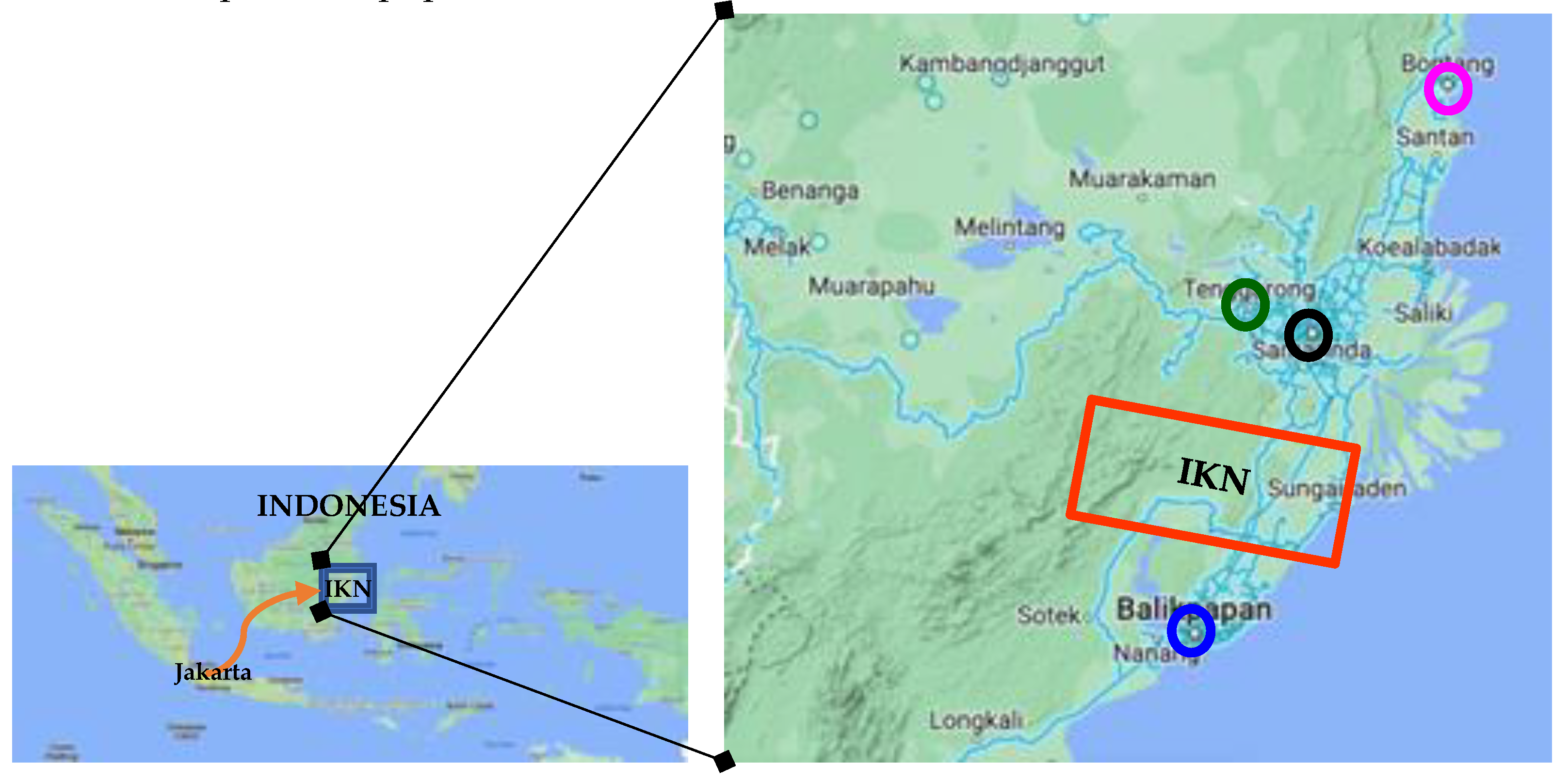

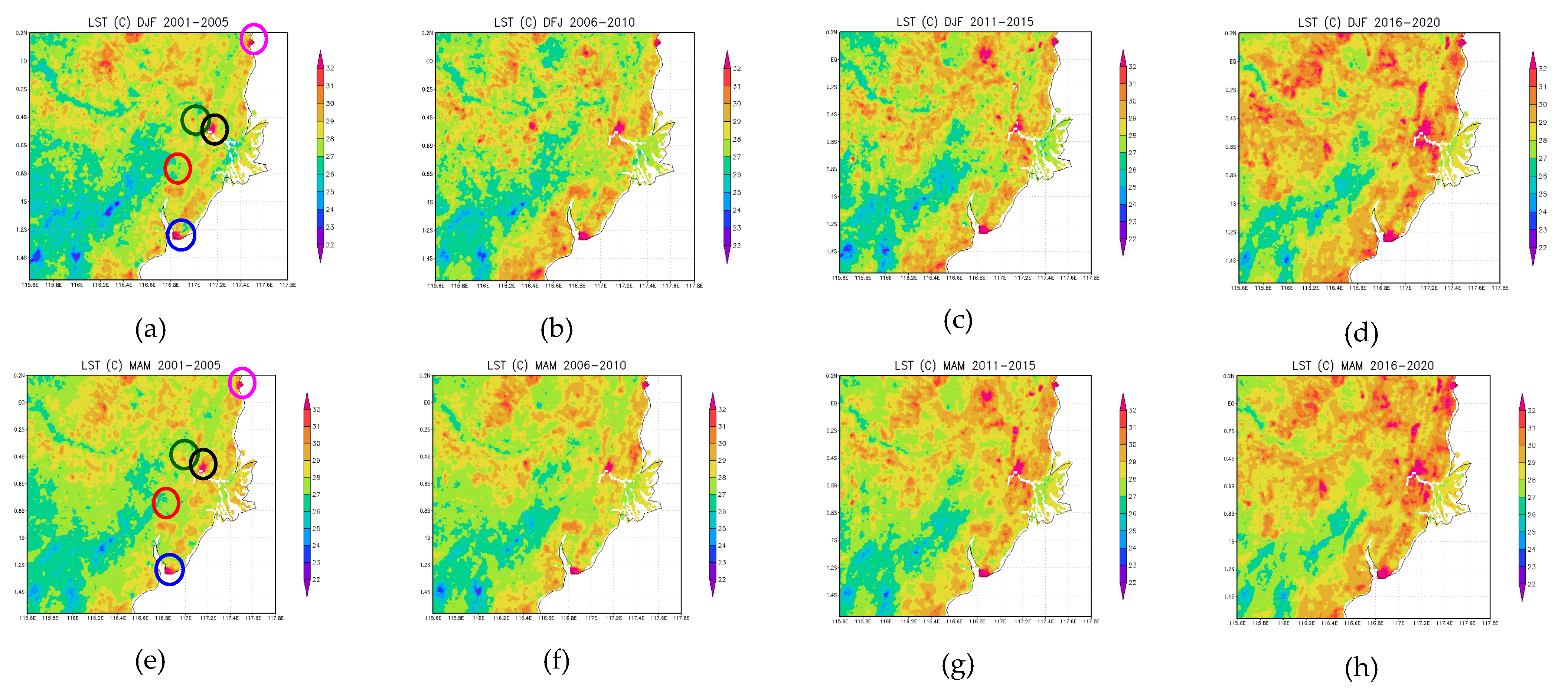

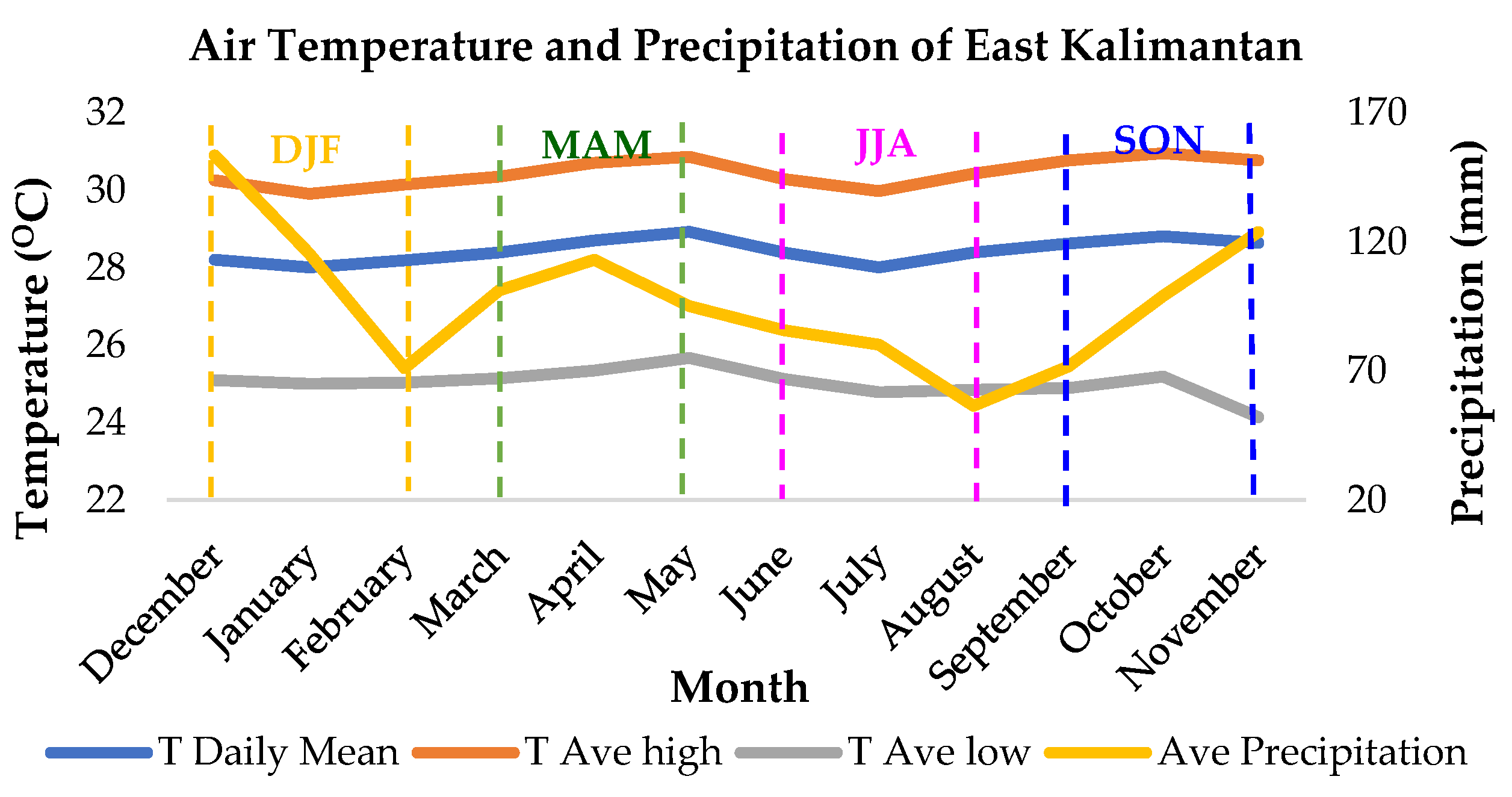
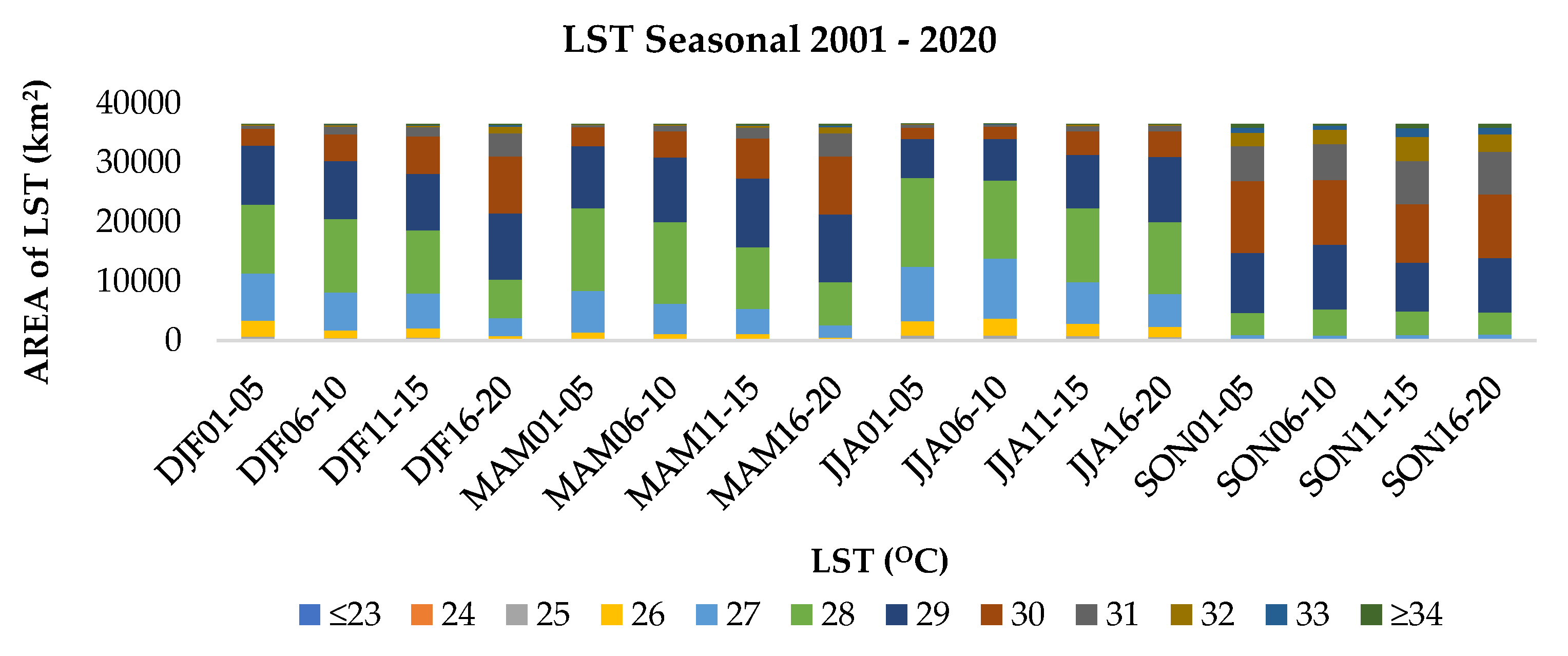

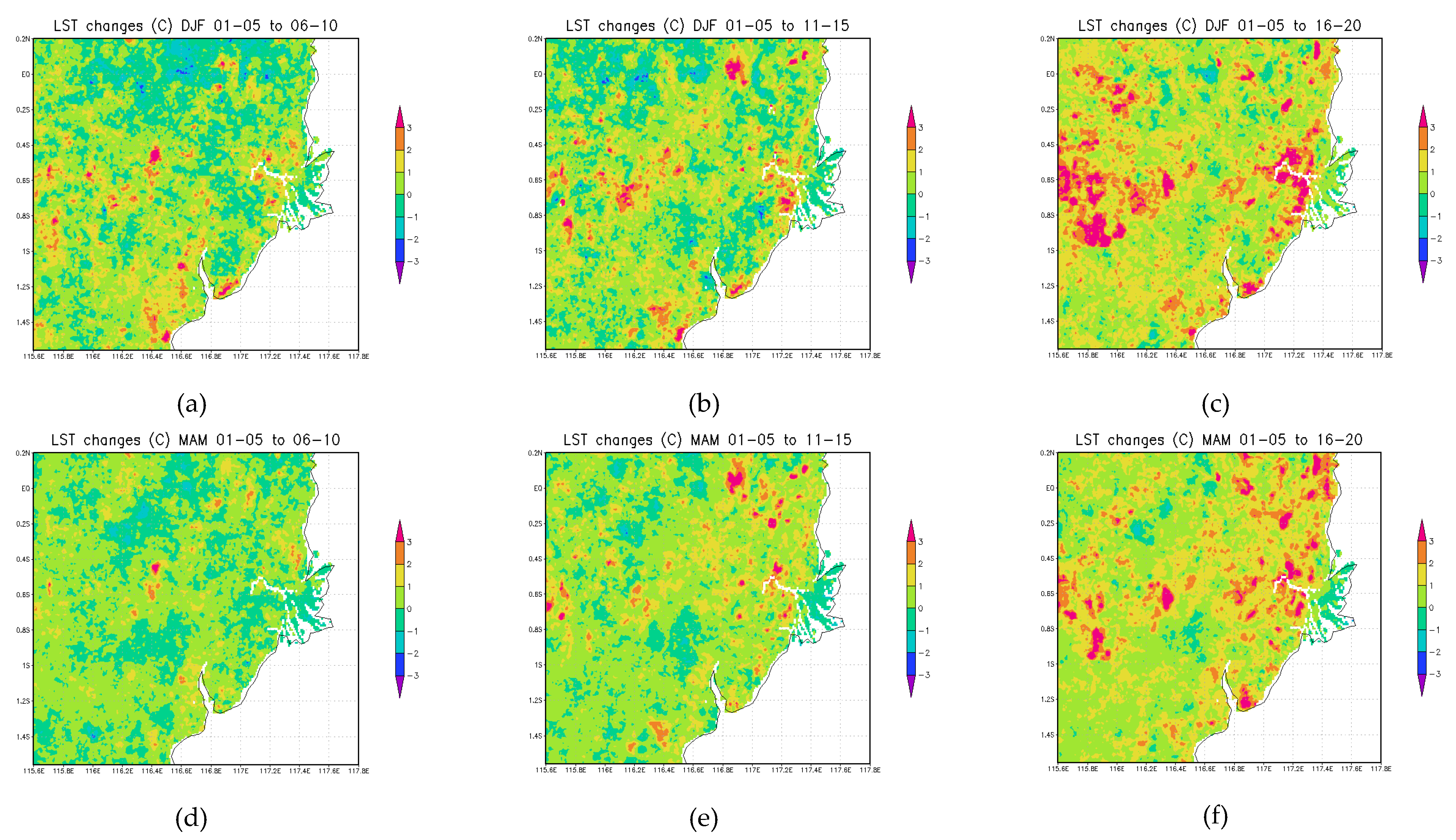

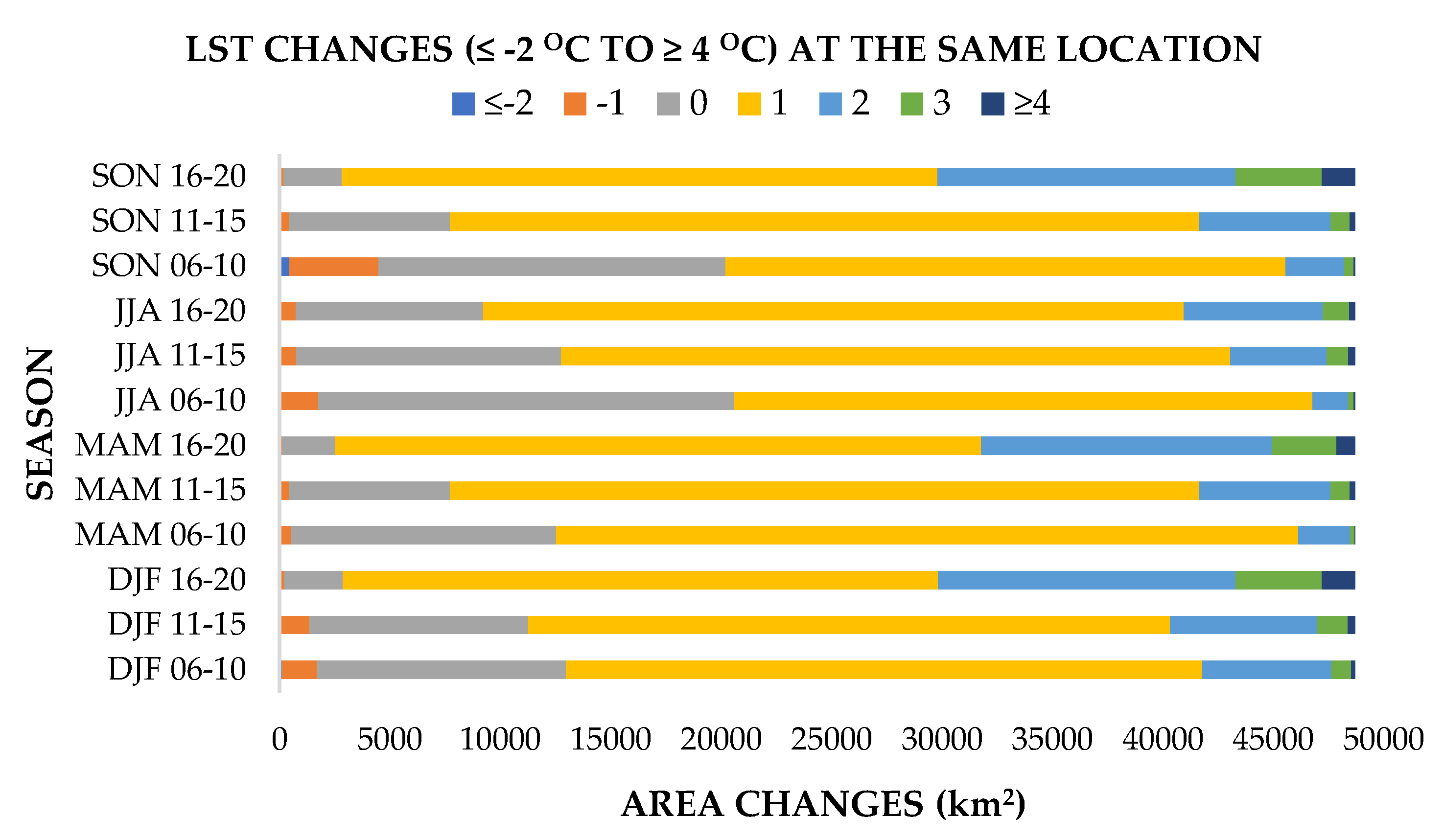
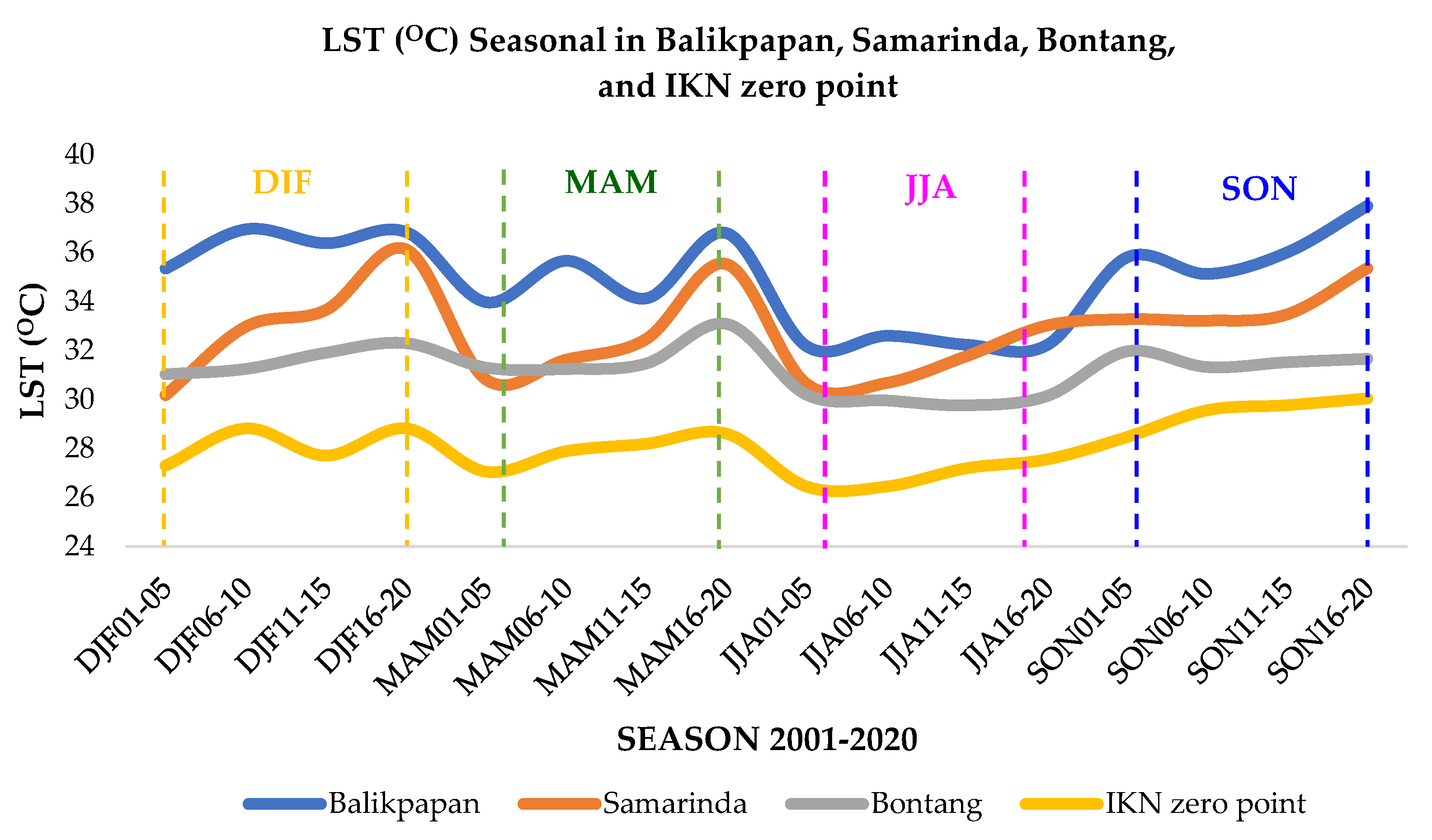



| LST (0C) | AREA OF LST SEASONAL (km2) | ||||||||||||||||||||||||||
|---|---|---|---|---|---|---|---|---|---|---|---|---|---|---|---|---|---|---|---|---|---|---|---|---|---|---|---|
| DJF 01-05 | DJF 06-10 | DJF 11-15 | DJF 16-20 | MAM 01-05 | MAM 06-10 | MAM 11-15 | MAM 16-20 | JJA 01-05 | JJA 06-10 | JJA 11-15 | JJA 16-20 | SON 01-05 | SON 06-10 | SON 11-15 | SON 16-20 | ||||||||||||
| ≤ 23 | 39 | 4 | 21 | 1 | 0 | 11 | 6 | 2 | 28 | 26 | 22 | 1 | 0 | 0 | 0 | 2 | |||||||||||
| 24 | 134 | 59 | 92 | 24 | 24 | 51 | 23 | 3 | 139 | 117 | 74 | 58 | 3 | 1 | 2 | 1 | |||||||||||
| 25 | 430 | 281 | 329 | 122 | 206 | 195 | 154 | 47 | 631 | 664 | 580 | 445 | 62 | 18 | 28 | 7 | |||||||||||
| 26 | 2686 | 1330 | 1599 | 606 | 1115 | 779 | 849 | 391 | 2415 | 2836 | 2083 | 1729 | 180 | 82 | 120 | 123 | |||||||||||
| 27 | 7954 | 6365 | 5879 | 2992 | 6981 | 5131 | 4250 | 2117 | 9169 | 10154 | 7075 | 5591 | 622 | 681 | 773 | 876 | |||||||||||
| 28 | 11589 | 12394 | 10592 | 6531 | 13962 | 13777 | 10427 | 7224 | 14960 | 13118 | 12420 | 12128 | 3702 | 4426 | 3939 | 3712 | |||||||||||
| 29 | 10008 | 9758 | 9542 | 11089 | 10402 | 10860 | 11535 | 11434 | 6618 | 7061 | 9021 | 10919 | 10203 | 10915 | 8252 | 9116 | |||||||||||
| 30 | 2820 | 4491 | 6317 | 9639 | 3248 | 4449 | 6817 | 9791 | 1888 | 1999 | 3985 | 4361 | 12032 | 10927 | 9817 | 10753 | |||||||||||
| 31 | 551 | 1338 | 1589 | 3883 | 362 | 930 | 1810 | 3914 | 497 | 351 | 878 | 954 | 5886 | 6017 | 7284 | 7201 | |||||||||||
| 32 | 151 | 253 | 252 | 1085 | 70 | 152 | 335 | 1022 | 70 | 66 | 182 | 145 | 2302 | 2421 | 4034 | 2913 | |||||||||||
| 33 | 34 | 71 | 100 | 283 | 23 | 41 | 108 | 273 | 14 | 27 | 68 | 52 | 878 | 693 | 1513 | 1150 | |||||||||||
| ≥ 34 | 14 | 38 | 49 | 74 | 25 | 27 | 54 | 82 | 3 | 6 | 37 | 25 | 371 | 174 | 421 | 372 | |||||||||||
| Total | 36435 | 36435 | 36435 | 36435 | 36435 | 36435 | 36435 | 36435 | 36435 | 36435 | 36435 | 36435 | 36435 | 36435 | 36435 | 36435 | |||||||||||
| LST (OC) | LST AREA CHANGES COMPARED TO 2001-2005 (km2) | |||||||||||
|---|---|---|---|---|---|---|---|---|---|---|---|---|
| dDJF 06-10 | dDJF 11-15 | dDJF 16-20 | dMAM 06-10 | dMAM 11-15 | dMAM 16-20 | dJJA 06-10 | dJJA 11-15 | dJJA 16-20 | dSON 06-10 | dSON 11-15 | dSON 16-20 | |
| ≤ 23 | -35 | -18 | -38 | -28 | -33 | -37 | -2 | -6 | -27 | 0 | 0 | 2 |
| 24 | -75 | -42 | -110 | -83 | -111 | -131 | -22 | -65 | -81 | -2 | -1 | -2 |
| 25 | -149 | -101 | -308 | -235 | -276 | -383 | 33 | -51 | -186 | -44 | -34 | -55 |
| 26 | -1356 | -1087 | -2080 | -1907 | -1837 | -2295 | 421 | -332 | -686 | -98 | -60 | -57 |
| 27 | -1589 | -2075 | -4962 | -2823 | -3704 | -5837 | 985 | -2094 | -3578 | 59 | 151 | 254 |
| 28 | 805 | -997 | -5058 | 2188 | -1162 | -4365 | -1842 | -2540 | -2832 | 724 | 237 | 10 |
| 29 | -250 | -466 | 1081 | 852 | 1527 | 1426 | 443 | 2403 | 4301 | 712 | -1951 | -1087 |
| 30 | 1671 | 3497 | 6819 | 1629 | 3997 | 6971 | 111 | 2097 | 2473 | -1105 | -2215 | -1279 |
| 31 | 787 | 1038 | 3332 | 379 | 1259 | 3363 | -146 | 381 | 457 | 131 | 1398 | 1315 |
| 32 | 102 | 101 | 934 | 1 | 184 | 871 | -4 | 112 | 75 | 119 | 1732 | 611 |
| 33 | 37 | 66 | 249 | 7 | 74 | 239 | 13 | 54 | 38 | -185 | 635 | 272 |
| ≥ 34 | 52 | 84 | 141 | 20 | 82 | 178 | 10 | 41 | 46 | -311 | 108 | 16 |
| dLST (0C) | AREA of LST changes (≤ -2 OC to ≥ 4 OC) at the same location (km2) | ||||||||||||||
|---|---|---|---|---|---|---|---|---|---|---|---|---|---|---|---|
| DJF 06-10 | DJF 11-15 | DJF 16-20 | MAM 06-10 | MAM 11-15 | MAM 16-20 | JJA 06-10 | JJA 11-15 | JJA 16-20 | SON 06-10 | SON 11-15 | SON 16-20 | Ave-rage | |||
| ≤ -2 | 119 | 94 | 36 | 8 | 5 | 6 | 22 | 4 | 24 | 456 | 5 | 2 | 65 | ||
| -1 | 1582 | 1266 | 183 | 538 | 441 | 124 | 1745 | 772 | 736 | 4047 | 441 | 183 | 1005 | ||
| 0 | 11297 | 9921 | 2656 | 12006 | 7299 | 2400 | 18812 | 12003 | 8492 | 15697 | 7299 | 2656 | 9212 | ||
| 1 | 28787 | 29052 | 26934 | 33587 | 33886 | 29237 | 26211 | 30275 | 31696 | 25367 | 33886 | 26967 | 29657 | ||
| 2 | 5860 | 6653 | 13503 | 2357 | 5966 | 13169 | 1609 | 4376 | 6297 | 2651 | 5966 | 13503 | 6826 | ||
| 3 | 897 | 1385 | 3897 | 192 | 881 | 2943 | 247 | 976 | 1198 | 419 | 881 | 3897 | 1484 | ||
| ≥ 4 | 166 | 337 | 1499 | 20 | 230 | 829 | 62 | 302 | 265 | 71 | 230 | 1500 | 459 | ||
| CITY | LST SEASONAL (OC) | |||||||||||||||||||||||||||
|---|---|---|---|---|---|---|---|---|---|---|---|---|---|---|---|---|---|---|---|---|---|---|---|---|---|---|---|---|
| DJF 01-05 | DJF 06-10 | DJF 11-15 | DJF 16-20 | MAM 01-05 | MAM 06-10 | MAM 11-15 | MAM 16-20 | JJA 01-05 | JJA 06-10 | JJA 11-15 | JJA 16-20 | SON 01-05 | SON 06-10 | SON 11-15 | SON 16-20 | |||||||||||||
| Balikpapan | 35.35 | 36.95 | 36.38 | 36.84 | 33.98 | 35.67 | 34.13 | 36.80 | 32.18 | 32.60 | 32.24 | 32.22 | 35.80 | 35.13 | 36.01 | 37.91 | ||||||||||||
| Samarinda | 30.18 | 32.98 | 33.66 | 36.13 | 30.82 | 31.63 | 32.48 | 35.53 | 30.64 | 30.68 | 31.77 | 33.02 | 33.28 | 33.22 | 33.48 | 35.36 | ||||||||||||
| Bontang | 31.03 | 31.25 | 31.91 | 32.30 | 31.30 | 31.25 | 31.47 | 33.09 | 30.20 | 29.96 | 29.76 | 30.14 | 31.96 | 31.33 | 31.52 | 31.66 | ||||||||||||
| IKN 0 point | 27.30 | 28.82 | 27.71 | 28.82 | 27.05 | 27.89 | 28.19 | 28.61 | 26.45 | 26.45 | 27.20 | 27.55 | 28.47 | 29.56 | 29.77 | 30.04 | ||||||||||||
Disclaimer/Publisher’s Note: The statements, opinions and data contained in all publications are solely those of the individual author(s) and contributor(s) and not of MDPI and/or the editor(s). MDPI and/or the editor(s) disclaim responsibility for any injury to people or property resulting from any ideas, methods, instructions or products referred to in the content. |
© 2023 by the authors. Licensee MDPI, Basel, Switzerland. This article is an open access article distributed under the terms and conditions of the Creative Commons Attribution (CC BY) license (http://creativecommons.org/licenses/by/4.0/).




